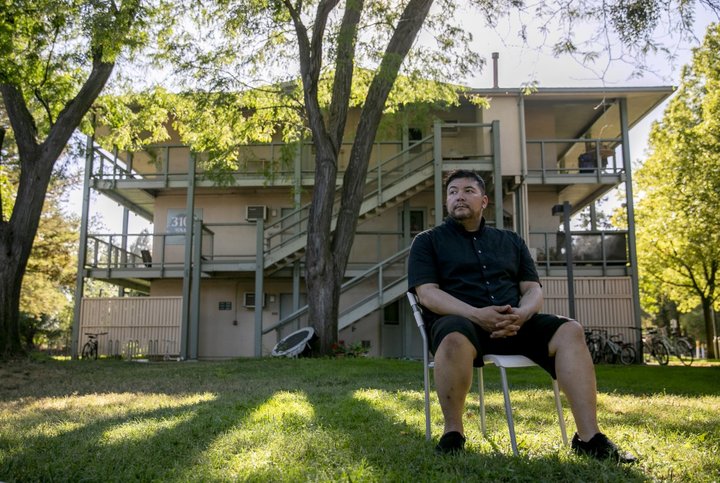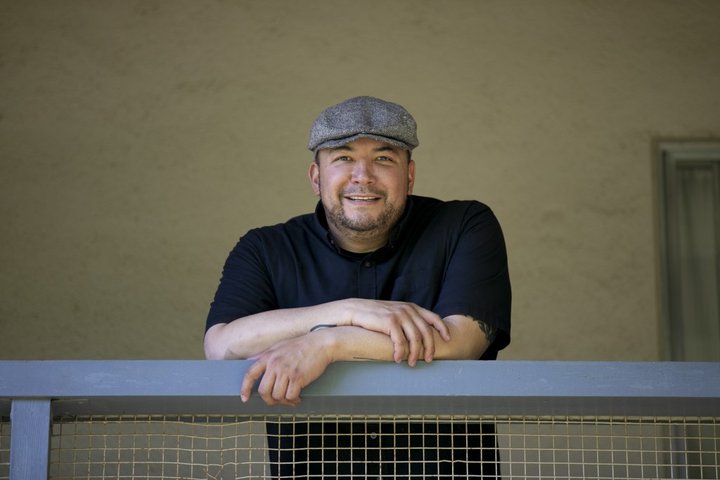
Marcelo Lopez, a fourth year student at UC Davis studying sociology and Chicano studies, sits for a portrait near the student housing complex where he and his wife live. Lopez is part of several campus groups that support and advocate for students who have gone though the criminal justice system. Photo by Anne Wernikoff for CalMatters.
###
A hit-and-run offender sits on a Zoom call with three other people: a facilitator and two community members. The facilitator asks the offender to explain the hit-and-run and how it felt to abandon damaged property. The community members also ask questions: Were you speeding? What was the weather like?
When everyone understands what happened, the offender creates a list of harms to self and community — and agrees to write apology letters to people they may have disappointed and to complete a defensive driving workbook.
If the offender doesn’t do those things, this case returns to court. But if they do, they won’t have a conviction on their criminal record.
It almost sounds like a kindergarten class — sit down and talk about what you did wrong. But it’s a program for adults, designed to reduce incarceration and reimagine criminal justice: Neighborhood Court.
Conversations about revamping the criminal justice system, from policing to prisons, are taking place in book clubs and on the streets. Over 95% of American adults surveyed in a June AP-NORC poll said the system needs at least minor changes.
California underwent its own criminal justice shift starting in 2011 with legislation giving county legal systems more control over nonviolent, non-serious and non-high risk offenders released from state prison. This realignment was aimed at reducing California’s prison population.
Neighborhood Court has been a part of Yolo County’s realignment plan since it was established in 2013 under District Attorney Jeff Reisig. A voluntary pre-filing and pre-trial diversion program, it allows low-level offenders to avoid having criminal charges on their record. Qualifying offenses include shoplifting, battery, possessing a switchblade, public drunkenness and petty theft.

Marcelo Lopez was once incarcerated for his first and only offense. Now a student at UC Davis, he became a volunteer at Neighborhood Court, a program he says would have changed his life. Photo by Anne Wernikoff for CalMatters
Offenders who opt in participate in a confidential “conference” with volunteers — usually three panelists and a facilitator — from the area where they committed the crime. Neighborhood Court volunteers suggest options for apology tasks. Nothing participants say can be used against them if their cases return to court.
During conferences before the coronavirus pandemic, the offender, the volunteers and the victim, if there is one, would sit in a circle a few feet away from each other.
“I wanted a way to set up the system to give victims an opportunity to be heard and engage the community in the process of justice,” said Reisig, who called it a way to reduce mass incarceration and “community reliance on jail and prisons.”
What does early data reveal about whether the program has been able to reduce Yolo County’s recidivism, defined by the California Department of Corrections and Rehabilitation as an arrest resulting in a conviction within three years of an individual’s release from jail or prison?
A 2018 state report found that prisoners released between 2013 and 2015 averaged a recidivism rate of about 46%, while an audit of Neighborhood Court found that participants who completed the program between 2013 and 2015 averaged a recidivism rate of just under 8%.
“It’s a civil and dignified opportunity for a young or first-time offender to not have an issue with the criminal justice system.”
— Marcelo Lopez, UC Davis student
While those numbers show a stark contrast, there’s a caveat: People released from state prison are likely to have committed more serious offenses than participants in Neighborhood Court.
The “secret sauce” to Neighborhood Court, Reisig said, is restorative justice — an alternative to traditional criminal justice proceedings. Rather than put an offender in front of a judge to discuss the facts of the case, restorative justice seeks to restore the emotional bond between the offender, the victim and the community.
Offenders acknowledge the harm they caused, listen to victims’ emotions and decide how to start repairing physical and emotional damage they’ve done. They can agree to perform community service in the area of the crime or complete addiction treatment.
Marcelo Lopez — a fourth-year UC Davis student who was formerly incarcerated for his first and only offense — says he’s majoring in sociology and Chicano/Chicana studies in part to tackle racism in the legal system. When an advisor suggested he volunteer at Neighborhood Court, he said he was “shocked” by the existence of the program, which he says would have changed his life.
“It’s a civil and dignified opportunity for a young or first-time offender to not have an issue with the criminal justice system,” said Lopez, who became a volunteer. “People shouldn’t have to live in the right place, have the right ZIP code or the right background to benefit from things like this.”
Tinisch Hollins became a volunteer in San Francisco’s Neighborhood Courts system from a different experience but with a similar motivation. She grew up seeing the impact of the crack epidemic outside her door, and lost two brothers to gun violence.
As the state director of Crime Survivors for Safety and Justice, a nonprofit advocating for victims’ rights policies, she said she strives to connect policymakers with the voices of Black, Brown and Indigenous people hurt by crime. And she sees restorative justice as a way for them to transform pain into power.
“They have a fractured relationship with not just the justice system, but even being seen as victims in the first place,” Hollins said. “Different communities have different ideas of what restorative justice looks and feels like.”
San Francisco’s ten Neighborhood Courts were created in 2012 under then-District Attorney George Gascón, a restorative justice advocate who modeled them after existing community courts that dealt primarily with infractions.
“The current criminal justice system is a failure,” said Gascón, a former Los Angeles assistant police chief now running for district attorney there.“You wouldn’t get onto a plane if you knew it was probably going to crash, but with the criminal justice system, you already have low expectations going in.”
Neighborhood court: The eligibility question
The Yolo County Neighborhood Courts program initially accepted only first-time offenders, but it has expanded its list of eligible crimes. Qualifying incidents are decided on a case-by-case basis, with police input.
Woodland Police Chief Derrek Kaff, who worked with Reisig to expand the program, acknowledged that it made some of his officers uncomfortable.
“When we started handling cases where officers were the victim, that took a culture shift,” Kaff said. “You have a group of existing employees who have been doing things one way for a long time and we have to get them to see the value of another way.”
Kara Hunter, executive director of the Yolo Conflict Resolution Center, a conflict mediation nonprofit, said she worked with Reisig and Neighborhood Courts program coordinator Nicole Kirkaldy to make sure the program was “supercharged” with restorative justice. That also meant training Neighborhood Court volunteers to recognize implicit bias and de-escalate situations.
“You have a group of existing employees who have been doing things one way for a long time and we have to get them to see the value of another way.”
— Derrek Kaff, Woodland Police Chief
“Some people come who just believe in the power of dialogue,” Hunter said. “Some people come with indignation and frustration by what they see in the regular criminal justice process. Some people who are coming, they want to see change.”
Another challenge Neighborhood Courts face: ensuring volunteers are representative of the communities they serve and that they can make participants comfortable enough to be vulnerable during conferences.
Recent UC Davis graduate Jasmine Vega, who interned and volunteered for Neighborhood Court, helped Kirkaldy broaden the program to include both English and Spanish conferences by the end of 2018.
“A lot of times, because translations aren’t the same from English to Spanish, I would see participants get scared or feel hesitant to share,” Vega said. “But when the program shifted, I saw a huge change — Spanish-speaking participants felt like their needs were incorporated and they started opening up more.”
Of 139 volunteers who participated in conferences last year, 37 spoke at least one other language and 19 were Spanish-speaking only, Kirkaldy said. Over 20% of Yolo County residents only speak Spanish, and over 30% of the county’s population is Spanish-speaking.
But a Neighborhood Court system isn’t the solution for everyone. Existing restorative justice-based courts exclude felonies such as rape or deliberate murder.
Sohmer Kristensen, who moved to California after a sexual assault, said she wouldn’t expect to receive actual justice from a criminal trial or a dialogue with the man who assaulted her.
“I like the idea of being able to communicate harm to my abuser,” Kristensen said. “But these sorts of conversations are predicated on someone having remorse. Even though I know that he knows what happened, he would never admit it.”
Still, she prefers the goal of rehabilitation over punishment.
“Justice to me, maybe, is giving me the space to be in pain and to heal with others,” she said. “That has nothing to do with my abuser, even if I want him separated from other victims — it’s mitigating future harm.”
Reisig said he doesn’t see that restorative justice approach completely replacing the current criminal justice system.
“We still need to be able to incapacitate people who are raping and molesting others,” Reisig said. “I don’t think there’s any disagreement on that from anybody, but there are so many other crimes where this is the absolute right solution.”
“I like the idea of being able to communicate harm to my abuser, but these sorts of conversations are predicated on someone having remorse.”
— Sohmer Kristensen, sexual abuse survivor
Americans now widely favor changing the criminal justice system, but the extent to which they want change differs along racial lines. In the AP-NORC poll, 57% of Black respondents — compared to 26% of white respondents — called for systemic overhaul.
“You can’t reform a system from its original intent,” said Jacqueline Azah, a Black activist from the San Joaquin County community of Mountain House who calls for dismantling, not reforming, the criminal justice system.
“I can’t turn a hairbrush into a microphone and forget it was ever a hairbrush,” she said.
Azah wants to see community programs that use restorative justice processes to deal with even those who have committed sexual or violent crimes.
UC Santa Cruz political science assistant professor Anjuli Verma says geography is also destiny.
“The places where people feel like they have a stake in someone’s welfare, where there are a lot of nonprofits and externally-funded resources, that’s where diversion programs are successful,” Verma said. “The SFs and the Yolo Counties are places that can’t get behind locking people up and throwing away the key.”
She called the current courts an experiment.
“These policy successes or failures are performances for other places in the state in a way that’s unique to California,” she said. “Criminal justice reform is so geographically varied within the state, but I think the pathway out of mass incarceration in California is going to come from the counties.”
###
CALmatters.org is a nonprofit, nonpartisan media venture explaining California policies and politics.
CLICK TO MANAGE